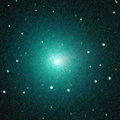
|
It approached to Earth down to 0.3 a.u. in mid February, and brightened up to 5.5 mag (Feb. 13, Juan Jose Gonzalez). Now it is fading. But it is still bright as 8.7 mag (Mar. 11, Marco Goiato). In the Southern Hemisphere, it will be unobservable soon. In the Northern Hemisphere, it will be getting lower gradually after this.
Date(TT) R.A. (2000) Decl. Delta r Elong. m1 Best Time(A, h)
Mar. 23 4 30.71 33 33.6 1.446 1.445 69 10.2 19:38 (102, 51)
Mar. 30 4 26.52 33 23.3 1.672 1.494 62 10.7 19:44 (105, 44)
|

|
It brightened up to 7.7 mag in June (June 19, Juan Jose Gonzalez). Now it is fading. But it is still bright as 11.2 mag (Mar. 4, Chris Wyatt). In the Southern Hemisphere, it stays observable in good condition for a long time until the comet will fade out. In the Northern Hemisphere, it is not observable for a long time until autumn when the comet fades out down to 16 mag.
Date(TT) R.A. (2000) Decl. Delta r Elong. m1 Best Time(A, h)
Mar. 23 4 16.91 -52 30.4 3.458 3.330 74 12.1 19:38 ( 29, -8)
Mar. 30 4 26.95 -49 44.4 3.535 3.384 73 12.2 19:44 ( 33, -8)
|

|
Now it is 13.5 mag (Jan. 27, Toshihiko Ikemura, Hirohisa Sato). It will be unobservable temporarily soon. But it will appear in the morning sky again at 13-14 mag in August.
Date(TT) R.A. (2000) Decl. Delta r Elong. m1 Best Time(A, h)
Mar. 23 1 40.02 9 42.9 2.875 2.016 24 12.4 19:38 ( 98, 6)
Mar. 30 1 56.11 10 59.3 2.904 2.014 22 12.4 19:44 (101, 3)
|
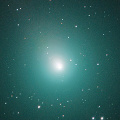
|
It approached to Earth down to 0.08 a.u. in mid December, and it brightened up to 3.4 mag (Dec. 14, Seiichi Yoshida). it looked so large as 3 times of Moon. Now it is fading. It has already faded down to 10.6 mag (Mar. 9, Juan Jose Gonzalez). In the Northern Hemisphere, it stays observable in excellent condition. In the Southern Hemisphere, it stays low for a while.
Date(TT) R.A. (2000) Decl. Delta r Elong. m1 Best Time(A, h)
Mar. 23 9 51.96 38 27.1 0.814 1.644 130 12.6 21:50 (180, 87)
Mar. 30 9 57.74 36 14.3 0.909 1.703 126 13.3 21:28 (180, 89)
|
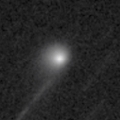
|
Now it is 14.3 mag (Feb. 21, Thomas Lehmann). It will brighten up to 10-11 mag in autumn. Now it is not observable. It will appear in the morning sky in mid May in the Southern Hemisphere, or in late June in the Northern Hemisphere.
Date(TT) R.A. (2000) Decl. Delta r Elong. m1 Best Time(A, h)
Mar. 23 1 28.54 -13 11.9 4.719 3.836 24 13.2 19:38 ( 81,-10)
Mar. 30 1 33.10 -11 34.0 4.711 3.799 21 13.2 19:44 ( 86,-15)
|
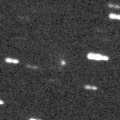
|
Now it is bright as 13.5 mag (Mar. 3, Taras Prystavski). It stays 13 mag for a long time in 2019. In the Southern Hemisphere, it is observable in excellent condition. In the Northern Hemisphere, it is not observasble until summer in 2020.
Date(TT) R.A. (2000) Decl. Delta r Elong. m1 Best Time(A, h)
Mar. 23 8 32.03 -59 57.7 2.728 3.179 107 13.2 20:28 ( 0, -5)
Mar. 30 8 14.06 -59 18.1 2.740 3.161 105 13.2 19:44 ( 0, -4)
|
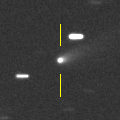
|
Now it is 12.3 mag (Mar. 5, Marco Goiato). It is observable in excellent condition in the Northern Hemisphere. It locates somewhat low in the Southern Hemisphere.
Date(TT) R.A. (2000) Decl. Delta r Elong. m1 Best Time(A, h)
Mar. 23 11 8.88 30 36.5 1.259 2.157 145 13.5 23:06 ( 0, 85)
Mar. 30 11 4.75 29 36.3 1.299 2.167 140 13.6 22:34 ( 0, 84)
|
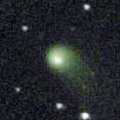
|
Now it is 13.9 mag (Mar. 13, Ken Harikae). It stays 13-14 mag until summer. It is observable in excellent condition in the Southern Hemisphere. In the Northern Hemisphere, it will be getting lower gradually, and it will be unobservable in July.
Date(TT) R.A. (2000) Decl. Delta r Elong. m1 Best Time(A, h)
Mar. 23 17 26.49 -26 0.4 2.997 3.308 99 13.6 4:36 (347, 28)
Mar. 30 17 21.42 -27 50.2 2.885 3.321 107 13.5 4:25 (353, 27)
|
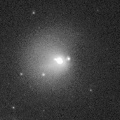
|
It is not observable now. It will appear in the morning sky in May.
Date(TT) R.A. (2000) Decl. Delta r Elong. m1 Best Time(A, h)
Mar. 23 23 54.18 5 55.1 6.757 5.767 6 13.9 4:36 (253,-12)
Mar. 30 23 59.46 6 32.8 6.752 5.767 8 13.9 4:25 (255,-10)
|
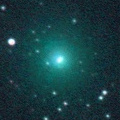
|
Now it is 12.6 mag (Mar. 8, Ken Harikae). It will be fading gradually after this. In the Northern Hemisphere, it stays observable for a long time until it fades out. But it stays extremely low. It will never be observable again in the Southern Hemisphere.
Date(TT) R.A. (2000) Decl. Delta r Elong. m1 Best Time(A, h)
Mar. 23 23 24.85 42 1.8 2.850 2.218 42 13.9 4:36 (229, 15)
Mar. 30 23 46.58 43 5.4 2.932 2.273 40 14.3 4:25 (227, 15)
|

|
Now it is 14.0 mag (Mar. 8, Toshihiko Ikemura, Hirohisa Sato). It will be fading after this.
Date(TT) R.A. (2000) Decl. Delta r Elong. m1 Best Time(A, h)
Mar. 23 5 34.10 -20 33.9 3.666 3.674 82 14.2 19:38 ( 33, 27)
Mar. 30 5 33.67 -20 16.7 3.806 3.721 77 14.4 19:44 ( 41, 23)
|
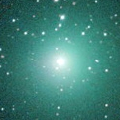
|
It brightened up to 9.0 mag from autumn to winter (Nov. 16, Maik Meyer). Now it is fading. But it is bright as 12.4 mag still now (Feb. 23, Seiichi Yoshida). It is observable in excellent condition in the Northern Hemisphere. It stays low in the Southern Hemisphere.
Date(TT) R.A. (2000) Decl. Delta r Elong. m1 Best Time(A, h)
Mar. 23 5 55.57 23 54.8 1.900 2.102 87 14.3 19:38 ( 70, 65)
Mar. 30 6 9.40 23 29.7 2.028 2.155 83 14.8 19:44 ( 75, 61)
|
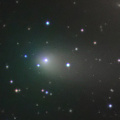
|
It brightened up to 9.5 mag from autumn to winter (Dec. 14, Marco Goiato). Now it is fading. But it is bright as 12.6 mag still now (Feb. 23, Seiichi Yoshida). In the Northern Hemisphere, it stays observable in good condition for a long time until it fades out. It locates low in the Southern Hemispehre.
Date(TT) R.A. (2000) Decl. Delta r Elong. m1 Best Time(A, h)
Mar. 23 8 45.10 43 4.3 1.619 2.256 117 14.4 20:44 (180, 82)
Mar. 30 8 51.97 41 53.2 1.736 2.312 112 14.8 20:23 (180, 83)
|
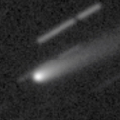
|
Now it is 13.5 mag (Mar. 4, Chris Wyatt). It will be fading after this, and it will be fainter than 18 mag in May.
Date(TT) R.A. (2000) Decl. Delta r Elong. m1 Best Time(A, h)
Mar. 23 11 26.33 -4 35.0 0.908 1.896 169 14.6 23:23 ( 0, 50)
Mar. 30 11 23.07 -3 57.9 0.953 1.930 162 14.9 22:53 ( 0, 51)
|
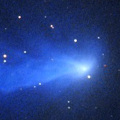
|
Now it is 15.3 mag (Mar. 8, Toshihiko Ikemura, Hirohisa Sato). It will be fading slowly after this. It is observable in good condition in the Northern Hemisphere. In the Southern Hemisphere, it stays extremely low for a while.
Date(TT) R.A. (2000) Decl. Delta r Elong. m1 Best Time(A, h)
Mar. 23 15 59.35 47 13.4 3.680 4.134 110 14.7 4:00 (180, 78)
Mar. 30 15 55.00 47 44.2 3.702 4.185 112 14.8 3:28 (180, 77)
|
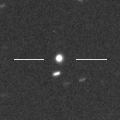
|
Now it is 13.6 mag (Feb. 27, S. Szabo). It is expected to brighten up to 7 mag in 2020. It will be unobservable temporarily in April.
Date(TT) R.A. (2000) Decl. Delta r Elong. m1 Best Time(A, h)
Mar. 23 3 10.34 4 27.0 5.586 4.946 46 14.9 19:38 ( 80, 21)
Mar. 30 3 13.91 5 17.6 5.601 4.883 40 14.8 19:44 ( 86, 15)
|

|
Now it is 14.5 mag (Aug. 16, P. Camilleri, H. Williams). It stays 15 mag from 2018 to 2019, and it will be observable for a long time in the Southern Hemisphere. In the Northern Hemisphere, it will never be observable again.
Date(TT) R.A. (2000) Decl. Delta r Elong. m1 Best Time(A, h)
Mar. 23 23 1.38 -52 0.6 4.438 3.944 54 14.9 4:36 (315,-31)
Mar. 30 23 12.41 -50 57.9 4.404 3.951 57 14.9 4:25 (314,-29)
|
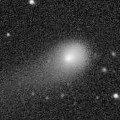
|
Now it is 14.9 mag (Mar. 1, Toshihiko Ikemura, Hirohisa Sato). It will be fading slowly after this. It is observable in excellent condition until spring in the Northern Hemispehre. In the Southern Hemisphere, it will be hardly observable after this.
Date(TT) R.A. (2000) Decl. Delta r Elong. m1 Best Time(A, h)
Mar. 23 9 17.74 42 43.8 4.463 5.067 122 15.0 21:15 (180, 82)
Mar. 30 9 9.24 41 59.1 4.597 5.106 115 15.1 20:39 (180, 83)
|

|
Now it is 14.2 mag (Feb. 4, ATLAS-MLO, Mauna Loa). It will be fading gradually after this. It is observable in excellent condition in the Northern Hemisphere. In the Southern Hemisphere, it is not observable until summer.
Date(TT) R.A. (2000) Decl. Delta r Elong. m1 Best Time(A, h)
Mar. 23 9 24.90 67 50.3 1.945 2.417 105 15.3 21:23 (180, 57)
Mar. 30 9 25.41 64 54.0 2.020 2.456 103 15.4 20:56 (180, 60)
|

|
Now it is 16.4 mag (Mar. 11, Toshihiko Ikemura, Hirohisa Sato). It will brighten up to 15 mag from May to June, and it will be observable in good condition.
Date(TT) R.A. (2000) Decl. Delta r Elong. m1 Best Time(A, h)
Mar. 23 19 45.41 -2 43.9 1.871 1.715 65 15.7 4:36 (300, 32)
Mar. 30 20 5.11 0 28.9 1.802 1.680 66 15.5 4:25 (297, 33)
|
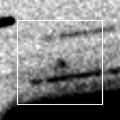
|
It will brighten up to 14 mag from May to June. However, it locates very low in the Northern Hemisphere, and it is not observable in the Southern Hemisphere.
Date(TT) R.A. (2000) Decl. Delta r Elong. m1 Best Time(A, h)
Mar. 23 22 49.45 26 49.5 2.472 1.711 32 15.8 4:36 (246, 12)
Mar. 30 23 4.64 30 29.6 2.378 1.647 34 15.5 4:25 (243, 15)
|
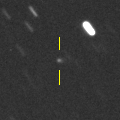
|
It is expected to brighten up to 10 mag in autumn. Now it is 16.5 mag (Feb. 27, Thomas Lehmann). In the Northern Hemisphere, it stays observable for a long time while the comet is brightening. In the Southern Hemisphere, it it not observable until mid September.
Date(TT) R.A. (2000) Decl. Delta r Elong. m1 Best Time(A, h)
Mar. 23 2 20.80 84 16.4 2.555 2.653 84 15.8 19:38 (173, 36)
Mar. 30 2 44.74 81 15.8 2.575 2.582 79 15.7 19:44 (169, 36)
|

|
First return of a new periodic comet discovered in 2014. The condition of this apparition is excelllent. It was expected to brighten rapidly, and to be observable at 15.5 mag in excellent condition in March. But it has not been recovered yet. In December, it was not detected, fainter than 20.0 mag (Dec. 10, Toshihiko Ikemura, Hirohisa Sato).
Date(TT) R.A. (2000) Decl. Delta r Elong. m1 Best Time(A, h)
Mar. 23 10 6.61 11 34.4 0.811 1.737 147 15.9 22:04 ( 0, 67)
Mar. 30 10 6.78 11 55.9 0.831 1.724 140 16.0 21:37 ( 0, 67)
|
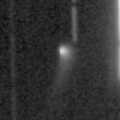
|
Now it is 16.5 mag (Mar. 7, Toshihiko Ikemura, Hirohisa Sato). It will be fading after this. In the Northern Hemisphere, it stays observable for a long time, but it will be extremely low from May to June. It is not observable at all in the Southern Hemisphere.
Date(TT) R.A. (2000) Decl. Delta r Elong. m1 Best Time(A, h)
Mar. 23 3 41.03 57 33.3 3.534 3.341 70 16.0 19:38 (139, 45)
Mar. 30 3 41.64 55 57.9 3.659 3.355 64 16.1 19:44 (137, 40)
|
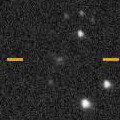
|
Now it is 17.4 mag (Jan. 3, Toshihiko Ikemura, Hirohisa Sato). It stays 16 mag for a long time from 2019 to 2020. It is observable in excellent condition in the Southern Hemisphere. It is hardly observable in the Northern Hemisphere.
Date(TT) R.A. (2000) Decl. Delta r Elong. m1 Best Time(A, h)
Mar. 23 13 39.60 -54 15.2 3.528 4.158 123 16.4 1:41 ( 0, 1)
Mar. 30 13 26.60 -55 36.1 3.448 4.123 126 16.3 1:01 ( 0, -1)
|
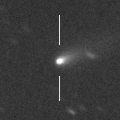
|
Although it was faint as 16-17 mag in November, it brightened up to 14.7 mag in December (Dec. 12, Toshihiko Ikemura, Hirohisa Sato). It is bright as 15.6 mag still now (Mar. 8, Toshihiko Ikemura, Hirohisa Sato). In the Northern Hemisphere, it stays observable in excellent condition after this. It stays extremely low in the Southern Hemisphere.
Date(TT) R.A. (2000) Decl. Delta r Elong. m1 Best Time(A, h)
Mar. 23 10 38.31 42 55.6 2.331 3.088 132 16.6 22:36 (180, 82)
Mar. 30 10 34.24 42 24.6 2.415 3.119 126 16.8 22:04 (180, 83)
|
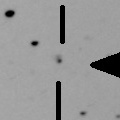
|
Asteroid, but it brightened rapidly. Now it is 17.3 mag (Nov. 14, Kunihiro Shima). It is observable in excellent condition in the Southern Hemisphere. It is hardly observable in the Northern Hemisphere.
Date(TT) R.A. (2000) Decl. Delta r Elong. m1 Best Time(A, h)
Mar. 23 22 25.23 -36 8.2 7.206 6.523 43 16.7 4:36 (302,-18)
Mar. 30 22 26.51 -36 3.7 7.123 6.514 49 16.7 4:25 (304,-15)
|

|
Now it is 16.8 mag (Mar. 8, Toshihiko Ikemura, Hirohisa Sato). It stays 16-17 mag for a long time until 2020. It is observable in good condition in the Northern Hemisphere. It is not observable at all in the Southern Hemisphere.
Date(TT) R.A. (2000) Decl. Delta r Elong. m1 Best Time(A, h)
Mar. 23 11 7.65 73 47.1 8.135 8.447 104 16.7 23:05 (180, 51)
Mar. 30 11 1.77 73 23.4 8.186 8.448 101 16.7 22:32 (180, 52)
|

|
Now it is 17.2 mag (Mar. 7, Toshihiko Ikemura, Hirohisa Sato). It is observable at 17 mag in good condition in 2019. It locates somewhat low in the Northern Hemisphere.
Date(TT) R.A. (2000) Decl. Delta r Elong. m1 Best Time(A, h)
Mar. 23 15 57.68 -16 29.8 3.200 3.810 120 17.0 3:58 ( 0, 38)
Mar. 30 15 57.17 -16 29.0 3.121 3.818 128 16.9 3:30 ( 0, 38)
|
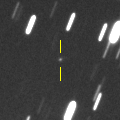
|
Now it is 17.5 mag (Mar. 8, Toshihiko Ikemura, Hirohisa Sato). It had been brightening even after the perihelion passage, but it is fading now. It will be fainter than 18 mag in May.
Date(TT) R.A. (2000) Decl. Delta r Elong. m1 Best Time(A, h)
Mar. 23 8 29.04 -1 14.1 1.042 1.814 125 17.0 20:27 ( 0, 54)
Mar. 30 8 37.64 -0 55.7 1.116 1.845 121 17.1 20:08 ( 0, 54)
|
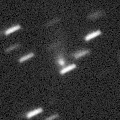
|
It brightened up to 8.7 mag in July (July 18, Marco Goiato). Now it is 19.9 mag (Feb. 28, Jean-Francois Soulier). It stays observable in good condition after this while the comet will be fading. But actually, it is fainter than this ephemeris.
Date(TT) R.A. (2000) Decl. Delta r Elong. m1 Best Time(A, h)
Mar. 23 16 19.56 -9 2.1 3.124 3.679 116 17.1 4:20 ( 0, 46)
Mar. 30 16 14.83 -7 39.8 3.100 3.756 124 17.2 3:48 ( 0, 47)
|
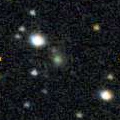
|
Now it is 16.3 mag (Mar. 11, Toshihiko Ikemura, Hirohisa Sato). It is expected to be observable at 5-6 mag for a long time from 2022 to 2023. In the Northern Hemisphere, it is not observable at the highlight from 2022 summer to 2023 summer. In the Southern Hemisphere, it stays unobservable for a while. But it will be observable in good condition at the highlight.
Date(TT) R.A. (2000) Decl. Delta r Elong. m1 Best Time(A, h)
Mar. 23 18 13.91 55 1.1 12.009 12.022 88 17.2 4:36 (213, 64)
Mar. 30 18 13.91 55 29.6 11.940 11.977 89 17.2 4:25 (208, 65)
|

|
Now it is 17.1 mag (Mar. 7, Toshihiko Ikemura, Hirohisa Sato). Fading slowly. It stays observable at 17 mag in good condition until summer.
Date(TT) R.A. (2000) Decl. Delta r Elong. m1 Best Time(A, h)
Mar. 23 11 33.63 9 19.0 9.072 10.046 167 17.3 23:31 ( 0, 64)
Mar. 30 11 32.20 9 37.0 9.113 10.057 160 17.3 23:02 ( 0, 65)
|
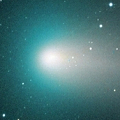
|
It brightened up to 6.8 mag in September (Sept. 17, Seiichi Yoshida). Now it is fading. Now it is 17.2 mag (Mar. 11, Toshihiko Ikemura, Hirohisa Sato).
Date(TT) R.A. (2000) Decl. Delta r Elong. m1 Best Time(A, h)
Mar. 23 6 33.58 -11 59.7 2.187 2.508 96 17.3 19:38 ( 21, 41)
Mar. 30 6 40.93 -10 27.7 2.315 2.566 92 17.5 19:44 ( 30, 40)
|
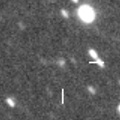
|
Now it is 18.2 mag (Oct. 8, Toshihiko Ikemura, Hirohisa Sato). It will brighten up to 16.5 mag in June. It is observable in excellent condition in the Southern Hemisphere. It locates low in the Northern Hemisphere.
Date(TT) R.A. (2000) Decl. Delta r Elong. m1 Best Time(A, h)
Mar. 23 18 54.91 -26 18.4 3.994 3.937 79 17.5 4:36 (327, 20)
Mar. 30 18 53.02 -27 18.7 3.837 3.913 86 17.3 4:25 (331, 21)
|
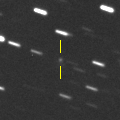
|
Now it is 17.2 mag (Mar. 7, Toshihiko Ikemura, Hirohisa Sato). It stays 17 mag from spring to summer. But it is hardly observable. In the Northern Hemisphere, it is observable only until May. In the Southern Hemisphere, it stays locating extremely low.
Date(TT) R.A. (2000) Decl. Delta r Elong. m1 Best Time(A, h)
Mar. 23 4 52.12 42 25.6 2.509 2.463 75 17.4 19:38 (116, 57)
Mar. 30 5 6.30 41 39.0 2.544 2.424 71 17.4 19:44 (115, 53)
|

|
First return of a new periodic comet which brightened up to 16.5 mag in 2005. Now it is 18.7 mag (Mar. 8, Toshihiko Ikemura, Hirohisa Sato). It will brighten up to 17.5 mag in spring.
Date(TT) R.A. (2000) Decl. Delta r Elong. m1 Best Time(A, h)
Mar. 23 13 16.24 -9 39.9 2.189 3.146 160 17.7 1:17 ( 0, 45)
Mar. 30 13 12.73 -9 21.7 2.141 3.125 168 17.6 0:46 ( 0, 46)
|
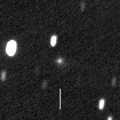
|
Now it is 17.1 mag (Mar. 7, Toshihiko Ikemura, Hirohisa Sato). It will be fading after this, and it will be fainter than 18 mag in May. It locates very low in the Southern Hemisphere.
Date(TT) R.A. (2000) Decl. Delta r Elong. m1 Best Time(A, h)
Mar. 23 5 59.65 42 20.6 3.892 3.987 88 17.6 19:38 (118, 69)
Mar. 30 6 5.39 42 6.2 4.005 4.003 82 17.7 19:44 (116, 64)
|
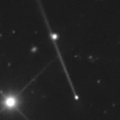
|
Main-belt asteroid. But it shows a straight tail like a comet. Now it is 17.0 mag (Mar. 11, Toshihiko Ikemura, Hirohisa Sato). It stays observable in excellent condition until early summer.
Date(TT) R.A. (2000) Decl. Delta r Elong. m1 Best Time(A, h)
Mar. 23 10 4.89 -1 21.9 1.403 2.318 149 17.7 22:02 ( 0, 54)
Mar. 30 10 1.61 0 32.1 1.431 2.302 142 17.8 21:31 ( 0, 56)
|

|
Now it is 19.3 mag (Mar. 11, Toshihiko Ikemura, Hirohisa Sato). It will brighten rapidly after this. It will be observable at 13.5 mag in good condition in autumn.
Date(TT) R.A. (2000) Decl. Delta r Elong. m1 Best Time(A, h)
Mar. 23 17 27.90 -11 36.3 2.483 2.826 99 18.1 4:36 (343, 42)
Mar. 30 17 33.85 -11 4.7 2.351 2.781 104 17.9 4:25 (346, 43)
|
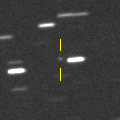
|
Now it is 17.6 mag (Mar. 7, Toshihiko Ikemura, Hirohisa Sato). It is observable at 18 mag in good condition from March to April.
Date(TT) R.A. (2000) Decl. Delta r Elong. m1 Best Time(A, h)
Mar. 23 14 24.77 14 60.0 1.931 2.788 142 17.9 2:26 ( 0, 70)
Mar. 30 14 19.38 15 58.0 1.943 2.833 147 17.9 1:53 ( 0, 71)
|
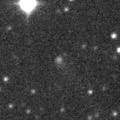
|
It was observed at 16 mag from 2017 to 2018. Now it is fading. It is observable at 18 mag in good condition in this spring.
Date(TT) R.A. (2000) Decl. Delta r Elong. m1 Best Time(A, h)
Mar. 23 16 7.72 8 21.7 6.927 7.465 119 17.9 4:08 ( 0, 63)
Mar. 30 16 6.72 9 14.1 6.875 7.493 125 17.9 3:40 ( 0, 64)
|
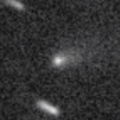
|
Now it is 17.6 mag (Mar. 7, Toshihiko Ikemura, Hirohisa Sato). It will be fading after this, and it will be fainter than 18 mag in March.
Date(TT) R.A. (2000) Decl. Delta r Elong. m1 Best Time(A, h)
Mar. 23 7 55.53 20 4.8 2.168 2.744 115 17.9 19:54 ( 0, 75)
Mar. 30 7 59.24 19 35.6 2.276 2.770 109 18.1 19:44 ( 12, 74)
|

|
It has not been observed yet in this apparition. It passed only 0.08 a.u. from Sun on Jan. 31. In the Northern Hemisphere, it is observable at 18 mag in excellent condition in March. It locates extremely low in the Southern Hemisphere.
Date(TT) R.A. (2000) Decl. Delta r Elong. m1 Best Time(A, h)
Mar. 23 14 55.83 53 55.1 0.552 1.329 115 18.1 2:59 (180, 71)
Mar. 30 13 37.81 52 13.7 0.640 1.447 122 18.4 1:14 (180, 73)
|
|
![]()
 C/2019 D1 ( Flewelling )
C/2019 D1 ( Flewelling ) C/2018 R3 ( Lemmon )
C/2018 R3 ( Lemmon ) C/2018 W2 ( Africano )
C/2018 W2 ( Africano ) P/2014 C1 ( TOTAS )
P/2014 C1 ( TOTAS ) C/2018 A3 ( ATLAS )
C/2018 A3 ( ATLAS ) C/2018 F4 ( PanSTARRS )
C/2018 F4 ( PanSTARRS ) 240P/NEAT
240P/NEAT A/2017 U7
A/2017 U7 C/2010 U3 ( Boattini )
C/2010 U3 ( Boattini ) 74P/Smirnova-Chernykh
74P/Smirnova-Chernykh 239P/LINEAR
239P/LINEAR C/2017 T3 ( ATLAS )
C/2017 T3 ( ATLAS ) C/2017 K2 ( PanSTARRS )
C/2017 K2 ( PanSTARRS ) C/2014 B1 ( Schwartz )
C/2014 B1 ( Schwartz ) 21P/Giacobini-Zinner
21P/Giacobini-Zinner C/2018 KJ3 ( Lemmon )
C/2018 KJ3 ( Lemmon ) C/2018 X2 ( Fitzsimmons )
C/2018 X2 ( Fitzsimmons ) P/2018 X1 ( LONEOS )
P/2018 X1 ( LONEOS ) 159P/LONEOS
159P/LONEOS (6478) Gault
(6478) Gault 68P/Klemola
68P/Klemola 49P/Arend-Rigaux
49P/Arend-Rigaux C/2017 E3 ( PanSTARRS )
C/2017 E3 ( PanSTARRS ) 59P/Kearns-Kwee
59P/Kearns-Kwee (394130) 2006 HY51
(394130) 2006 HY51![]()





































